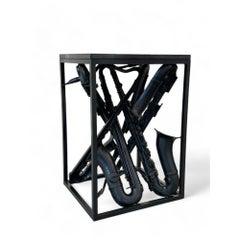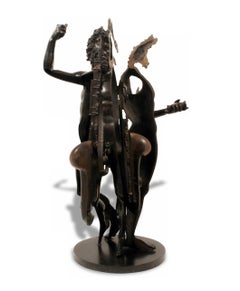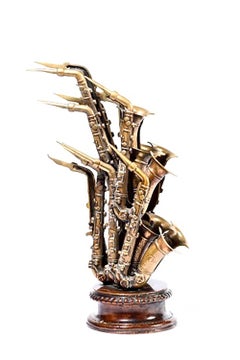Arman Saxophone
Arman, Saxophone Table Base, Polished Bronze Sculpture, Signed, ca. 1990
By Arman
Located in Paris, FR
This striking table base by French-American artist Arman (1928–2005) embodies the spirit of his
Category
1980s Mixed Media
Materials
Bronze
$45,722
H 27.37 in W 17.72 in D 19.49 in
Arman Sliced Bronze Sculpture Orgueil Masculin Heracles and Saxophone
By Arman
Located in Paris, FR
In 1987, Arman began his Transculptures series, created by combining sections of several objects on
Category
1980s Figurative Sculptures
Materials
Bronze
$77,193
H 40.95 in W 23.63 in D 29.93 in
Recent Sales
Bronze sculpture "Saxophones" by Fernandez Arman
By Arman
Located in Palm Beach, FL
only; he retained a printer’s 1958 misspelling of his name for the rest of his career.)
Arman is best
Category
21st Century and Contemporary Conceptual Figurative Sculptures
Materials
Bronze
Get Updated with New Arrivals
Save "Arman Saxophone", and we’ll notify you when there are new listings in this category.
Arman for sale on 1stDibs
Arman was born in Nice, France, in 1928, and showed a talent for painting and drawing as a child. He studied at the the Ecole Nationale des Art Décoratifs in Nice followed by studies at the École du Louvre in Paris.
In his early years he focused on abstract paintings. Then, in 1957, he became interested in common objects as works of art. He first did what came to be called his "allures d"objet" (object impressions), where he would dip an object into paint and press it on canvas thus leaving the object's shadow or impression. Then he decided the object itself was worth paying attention to and started to treat them in his own way. His intention was to remove the material purpose of an object so that its only remaining function was to "feed the mind" as a work of art. What better way to achieve that result than by breaking, slicing or even burning objects such as violins, telephones, typewriters or even whole cars? He also made objects useless by accumulating them, such as 2,000 wristwatches in a Plexiglass box that all kept different time.
Once emotionally detached from the circumstances associated with a broken object, the viewer could grow to appreciate its abstract beauty; so, in a sense, Arman was literally teaching that things one never thought could be regarded as attractive could indeed turn out to be so. Through this achievement, Arman gained worldwide recognition and is regarded as one of the most prolific and inventive creators of the late 20th century.
His work can be found in the collections of numerous museums including the Metropolitan Museum of Art in New York, the Tate Gallery in London and the Centre Pompidou in Paris.
Arman’s work has also been exhibited in galleries, museums and public spaces worldwide including the Musée D’Art Contemporain in Tehran, Iran; the Museum of Art in Tel Aviv, Israel; the Musée Des Arts Decoratifs and Opéra De Paris in France; the La Jolla Museum of Contemporary Art in California; and the Museum of Arts and Design and the Guggenheim in New York
He died in 2005 in New York.
More Ways To Browse
Media Console
Vintage Media Console
Chinese Carving Polychrome
Iranian Bronze
Monterrey Table
Jean Pascal
Violin Jewelry
1989 Prada
Obelisk Bronze French
Statues By A Moreau
Spanish Iron Garden Table
Violin Table
Christian Dior Vintage 1997
Gres Paris
Portugal Coffee Table Antique
Mexican Iron Coffee Table
Art Nouveau Piano
Haus Otto


